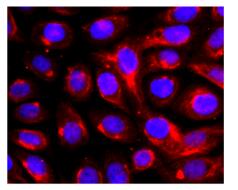中文名稱 突觸后密度蛋白93重組兔單克隆抗體
別 名 Channel associated protein of synapse 110; Channel associated protein of synapses 110kD; Channel-associated protein of synapse-110; Chapsyn 110; Chapsyn-110; Chapsyn110; discs large homolog 2; Discs, large homolog 2 (Drosophila); Disks large homolog 2; DKFZp781D1854; DKFZp781E0954; Dlg 2; dlg2; DLG2_HUMAN; Dlgh 2; Dlgh2; FLJ37266; Gm1197; MGC131811; Postsynaptic density protein PSD 93; Postsynaptic density protein PSD-93; Postsynaptic density protein PSD93; PSD 93; PSD93.
研究領域 細胞生物 免疫學 神經(jīng)生物學 信號轉(zhuǎn)導
抗體來源 Rabbit
克隆類型 Monoclonal
克 隆 號 6D1
交叉反應 (predicted: Human, Mouse, Rat, )
產(chǎn)品應用 WB=1:500-2000 IP=1:10-50
not yet tested in other applications.
optimal dilutions/concentrations should be determined by the end user.
分 子 量 98kDa
細胞定位 細胞膜
性 狀 Liquid
濃 度 1mg/ml
免 疫 原 KLH conjugated synthetic peptide derived from human PSD93/DLG2:
亞 型 IgG
純化方法 affinity purified by Protein A
儲 存 液 0.01M TBS(pH7.4) with 1% BSA, 0.03% Proclin300 and 50% Glycerol.
保存條件 Shipped at 4℃. Store at -20 °C for one year. Avoid repeated freeze/thaw cycles.
PubMed PubMed
產(chǎn)品介紹 PSD 93 is believed to participate in the clustering of certain proteins, including N-methyl-D-aspartate (NMDA) receptors and shaker-type potassium channels at the synaptic membrane. There are two principal modes of interaction between PSD 93 and other proteins. NMDA receptors and shaker-type potassium channels both share C-terminal sequence homology consisting of a threonine/serine-X-valine-COOH (T/SXV) motif. Other neuronal proteins that share this motif (beta 1 adrenergic receptor, some serotonin receptors, some sodium channel subunits, and additional potassium channel subunits) may interact with PSD 93 by binding to its PDZ domains. Neuronal nitric oxide synthase (nNOS), which lacks the T/SXV motif but which has its own PDZ domain, has been shown to associate with PSD 93 in vitro through a pseudo-homotypic PDZ-PDZ interaction.
Function:
Required for perception of chronic pain through NMDA receptor signaling. Regula
我要詢價
*聯(lián)系方式:
(可以是QQ、MSN、電子郵箱、電話等,您的聯(lián)系方式不會被公開)
*內(nèi)容:









